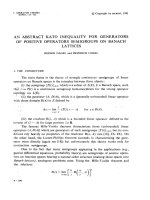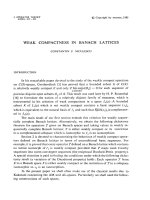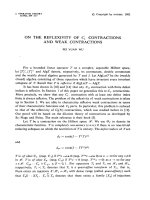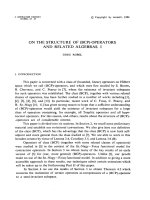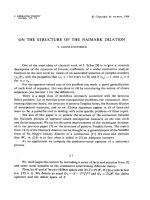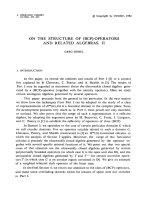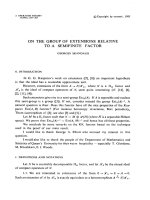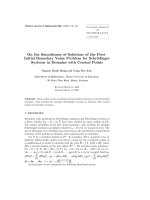Báo cáo toán học: "On the number of perfect matchings and Hamilton cycles in -regular non-bipartite graphs" ppsx
Bạn đang xem bản rút gọn của tài liệu. Xem và tải ngay bản đầy đủ của tài liệu tại đây (152.31 KB, 11 trang )
On the number of perfect matchings and Hamilton
cycles in -regular non-bipartite graphs
Alan Frieze
∗
Department of Mathematical Sciences
Carnegie Mellon University
Pittsburgh PA15213, USA
Submitted July 4, 2000, Accepted November 19, 2000
Abstract
A graph G =(V,E)onn vertices is super -regular if (i) all vertices have
degree in the range [(d − )n, (d + )n], dn being the average degree, and (ii)
for every pair of disjoint sets S, T ⊆ V, |S|, |T |≥n, e(S, T ) is in the range
[(d −)|S||T |, (d + )|S||T |]. We show that the number of perfect matchings lies in
the range [((d −2)
ν
n!
ν!2
ν
, (d +2)
ν
n!
ν!2
ν
], where ν =
n
2
, and the number of Hamilton
cycles lies in the range [(d − 2)
n
n!, (d +2)
n
n!].
1 Introduction
Let G =(V,E) be a graph with |V | = n.Let0<d<1and>0 be constants
(independent of n)where is assumed to be small compared with d. We assume that
the density of G is d i.e. |E|/
n
2
= d. Suppose that the following two conditions hold:
• If d
G
denotes vertex degree in G then
(d − )n ≤ d
G
(v) ≤ (d + )n for all v ∈ V. (1)
∗
Supported in part by NSF Grant CCR9818411
Mathematics Subject Classification (1991); primary 05C50, 05C70, secondary 05C80
1
the electronic journal of combinatorics 7 (2000), #R57 2
• If for S, T ⊆ V, S ∩ T = ∅ we let e(S, T) denote the number of edges of G with
one end in S and the other in T and d(S, T)=
e(S,T )
|S||T |
then
|d(S, T ) −d|≤ for all S, T ⊆ V, S ∩ T = ∅, |S|, |T |≥n. (2)
A graph satisfying (1),(2) said to be super -regular. We assume that n =2ν is even.
Let m(G) denote the number of perfect matchings in G and let h(G) denote the number
of Hamilton cycles in G. In this paper we prove
Theorem 1 If is sufficiently small and n is sufficiently large then
(a)
(d − 2)
ν
n!
ν!2
ν
≤ m(G) ≤ (d +2)
ν
n!
ν!2
ν
.
(b)
(d −2)
n
n! ≤ h(G) ≤ (d +2)
n
n!.
In both cases the bounds are “close” to the expected number of in the random graph
G
n,d
. The results here are strongly related to the result of Alon, R¨odl and Ruci´nski [2].
They considered bipartite graphs H with vertex partition A, B where |A| = |B| = n.
Assuming (1) and (2) for S ⊆ A and T ⊆ B they proved
Theorem 2 [2]
(d −2)
n
n! ≤ m(G) ≤ (d +2)
n
n!.
Michael Krivelevich has made some interesting observations on Theorem 1: First of
all, part (b) of Theorem 1 improves Corollary 2.9 of Thomason [9] which estimates the
number of Hamilton cycles in a pseudo-random graph. Secondly, if G is dn-regular and
the second eigenvalue of the adjacency matrix of G is at most ηdn for small η,thenG is
super (η)-regular (see for example Chung [4] Theorem 5.1) and so our result holds for
such graphs.
We note that a similar result can be proven for the number of spanning trees in such
a graph: if t(G) denotes the number of spanning trees of G then
(d − 2)
n−1
n
n−2
≤ t(G) ≤ (d +2)
n−1
n
n−2
. (3)
This follows from results of Alon [1] and Kostochka [7].
We prove Theorem 1(a) in the next section and Theorem 1(b) in Section 3. For
completeness, we also give a proof of (3) in Section 4.
the electronic journal of combinatorics 7 (2000), #R57 3
2 Perfect Matchings
Let A, B, |A| = |B| = ν be a partition of V . We re-express (2) in terms of ν i.e.
|d(S, T ) −d|≤ for all S ⊆ A, T ⊆ B, |S|, |T |≥2ν. (4)
Furthermore, if A, B is a random partition and H = H(A, B) is the bipartite sub-graph
of G induced by A, B then with high probability d
H
(v) ∈ [(d−−o(1))ν, (d + + o(1))ν]
for all v ∈ V . Thus the conditions of Theorem 2 are satisfied with ν replacing n and 2
replacing . It follows immediately that
m(H) ≥ (1 − o(1))
n
ν
×ν!(d − 2)
ν
×
1
2
ν
=(1−o(1))
n!
ν!2
ν
(d −2)
ν
. (5)
The factor
1
2
ν
accounts for the fact that each perfect matching occurs in 2
ν
different
graphs H, assuming we consider the partition A, B distinct from B, A. There is slack in
the calculation in [2] and this will absorb the 1 − o(1) term and so (5) proves the lower
bound in Theorem 1.
For the upper bound we follow [2] and use the Minc conjecture [8] proved by Bregman
[3]. For a partition A, B and v ∈ A let d
B
(v) denote the number of G-neighbours of v
in B. The Minc conjecture then states that
m(H) ≤
v∈A
(d
B
(v))!
1/d
B
(v)
.
Thus
m(G) ≤
1
2
ν
A,B
v∈A
(d
B
(v))!
1/d
B
(v)
. (6)
For a fixed A,weletA
1
= {v ∈ A : d
B
(v) > (d + )ν}. Property (1) implies that
|A
1
|≤n.Nowsince(x!)
1/x
increases with x, we see, after using Stirling’s approximation
and (1), that
v∈A
(d
B
(v))!
1/d
B
(v)
≤
d +
e
ν
|A\A
1
|
d +
e
n
|A
1
|
1+O
ln n
n
ν
≤
d +
e
ν
ν
2
n
n
O(1)
.
Hence
m(G) ≤
1
2
ν
n
ν
d +
e
ν
ν
2
n
n
O(1)
≤ (d +2)
ν
n!
ν!2
ν
completing the proof of part (a) of Theorem 1.
the electronic journal of combinatorics 7 (2000), #R57 4
3 Hamilton Cycles
A Hamilton cycle is the union of two perfect matchings and so h(G) ≤
1
2
m(G)
2
and the
upper bound in part (b) of Theorem 1 follows from the upper bound in part (a).
The lower bound requires more work. For 1 ≤ k ≤n/3,letΦ
k
be the set of all
2-factors in G containing exactly k cycles, and let Φ = ∪
k
Φ
k
be the set of all 2-factors.
Let f
k
= |Φ
k
| so that f
1
= h(G). If M is a perfect matching of G,leta
M
denote the
number of perfect matchings of G that are disjoint from M. Since deleting M only
disturbs -regularity marginally, we see by part (a) that a
M
≥ (d −2)
ν
n!
ν!2
ν
.Thus
A
G
=
M∈G
a
M
≥
(d −2)
ν
n!
ν!2
ν
2
≥ (d −2)
n
n! ×
1
3n
1/2
. (7)
On the other hand, we have
A
G
≤
n/3
k=1
2
k
f
k
. (8)
We will show by a relatively crude argument that where k
1
=
4
(d−2)(d−)
f
k+1
f
k
≤ n
3
1 ≤ k ≤ k
1
. (9)
We then use an idea from Dyer, Frieze and Jerrum [5]. In this paper they show that if
an n vertex graph G has minimum degree δ(G) ≥ (
1
2
+ α)n for a positive constant α,
then a polynomial fraction of the 2-factors of G are Hamilton cycles. We extend their
argument to -regular graphs.
Let β =
200
(d−2)(d−)
2
.Letk
0
= β ln n,andfor1≤ k ≤ n, define γ(k)=
n
β
k!(β ln n)
−k
,and
φ(k)=
γ(k),ifk≤ k
0
;
γ(k
0
), otherwise.
Lemma 1 Let φ be the function defined above. Then
1. φ is non-increasing and satisfies
min{φ(k −1),φ(k − 2)} = φ(k − 1) ≥ (β ln n)k
−1
φ(k);
2. φ(k) ≥ 1, for all k.
Proof Observe that γ is unimodal, and that k
0
is the value of k minimizing γ(k);
it follows that φ is non-increasing. When k ≤ k
0
,wehaveφ(k − 1) = γ(k − 1) =
(β ln n)k
−1
γ(k)=(β ln n)k
−1
φ(k); otherwise, φ(k−1) = γ(k
0
)=φ(k) ≥ (β ln n)k
−1
φ(k).
In either case, the inequality in part 1 of the lemma holds.
the electronic journal of combinatorics 7 (2000), #R57 5
Part 2 of the lemma follows from the chain of inequalities
1
φ(k)
≤
1
γ(k
0
)
≤
(β ln n)
k
0
n
β
k
0
!
≤ n
−β
∞
k=0
(β ln n)
k
k!
= n
−β
exp(β ln n)=1.
Define
Ψ=
(F, F
):F ∈ Φ
k
,F
∈ Φ
k
,k
<k, and F ⊕F
is a 6-cycle
,
where ⊕ denotes symmetric difference. Observe that Γ = (Φ, Ψ) is an acyclic directed
graph; let us agree to call its component parts nodes and arcs to avoid confusion with
the vertices and edges of G. Observe also that if (F, F
) ∈ Ψisanarc,thenF
can be
obtained from F by deleting three edges and adding three others, and that this operation
can decrease the number of cycles by at most two. Thus every arc (F, F
) ∈ Ψ is directed
from a node F in some Φ
k
to a node F
in Φ
k−1
or Φ
k−2
.
Our proof strategy is to define a positive weight function w on the arc set Ψ such that
the total weight of arcs leaving each node (2-factor) F ∈ Φ
≥k
1
is significantly greater
than the total weight of arcs entering F. We will show below that
F
+
:(F,F
+
)∈Ψ
w(F, F
+
) ≥ 100φ(k)n
2
ln nF∈ Φ
k
,k ≥ k
1
, (10)
F
−
:(F
−
,F )∈Ψ
w(F
−
,F) ≤ 9φ(k)n
2
H
n
F ∈ Φ
k
,k ≥ 1, (11)
where H
n
=
n
i=1
i
−1
≤ ln n +1isthenth harmonic number.
Now let
W
k,l
=
F ∈Φ
k
,F
∈Φ
l
(F,F
)∈Ψ
w(F, F
).
Then (10) and (11) imply that for k ≥ k
1
,
W
k+2,k
+ W
k+1,k
≤ 9f
k
φ(k)n
2
H
n
(12)
W
k,k−1
+ W
k,k−2
≥ 100f
k
φ(k)n
2
ln n. (13)
Now (13) implies that either
(i) W
k,k−1
≥ 50f
k
φ(k)n
2
ln n so that from (12)(k-1) we have
f
k−1
f
k
≥ 5
φ(k)
φ(k − 1)
or
(ii) W
k,k−2
≥ 50f
k
φ(k)n
2
ln n so that from (12)(k-2) we have
f
k−2
f
k
≥ 5
φ(k)
φ(k − 2)
the electronic journal of combinatorics 7 (2000), #R57 6
It follows that if k ≥ k
0
+2then
f
k
≤ 5
−(k−k
0
)/2
max{f
k
0
+1
,f
k
0
}.
Then from (8) we see that
A
G
≤
√
5
√
5 −2
k
0
+1
k=1
2
k
f
k
≤
√
5
√
5 −2
2
k
0
+1
k
0
+1
k=1
f
k
. (14)
Furthermore, since F ∈ Φ
k
,k >k
1
implies that
F
+
:(F,F
+
)∈Ψ
w(F, F
+
) −
F
−
:(F
−
,F )∈Ψ
w(F
−
,F) ≥ 1
the total weight of arcs entering Φ
k
1
is an upper bound on the number of 2-factors in G
with more than k
1
cycles and the maximum total weight of arcs entering a single node
in Φ
k
1
is an upper bound on the ratio ρ =
f
k
1
+1
+f
k
1
+2
+···+f
n/3
f
k
1
.Thus
ρ ≤ 9φ(1)n
2
H
n
= O(n
2+β
).
Combined with (14) and (9) we see that
A
G
≤ n
O(1)
f
1
(15)
and the lower bound in Theorem 1(b) follows from (7), modulo taking advantage of slack
to absorb the n
O(1)
term.
3.1 Proofs of (10) and (11)
The weight function w :Ψ→ R
+
we employ is defined as follows. For any arc (F
,F)
with F ∈ Φ
k
: if the 2-factor F is obtained from F
by coalescing two cycles of lengths l
1
and l
2
into a single cycle of length l
1
+ l
2
,thenw(F
,F)=(l
−1
1
+ l
−1
2
)φ(k); if F results
from coalescing three cycles of length l
1
, l
2
and l
3
into a single one of length l
1
+ l
2
+ l
3
,
then w(F
,F)=(l
−1
1
+ l
−1
2
+ l
−1
3
)φ(k).
Let F ∈ Φ
k
be a 2-factor with k>1cyclesC
1
,C
2
, ,C
k
,oflengthsn
1
,n
2
, ,n
k
.
We proceed to bound from below the total weight of arcs leaving F . For this purpose
imagine that the cycles C
1
,C
2
, ,C
k
are oriented in some way, so that we can speak
of each oriented edge (u, u
)insomecycleC
i
as being “forward” or “backward”. For
each vertex a wecanthenlet(a, π(a)) be the unique forward edge containing a.Since
we are interested in obtaining a lower bound, it is enough to consider only arcs (F, F
+
)
from F of a certain kind: namely, those for which the 6-cycle C = F ⊕F
+
is of the form
C =(x, x
,y,y
,z,z
), where (x, x
) ∈ F is a forward cycle edge, (y,y
) ∈ F is a forward
edge in a cycle distinct from the first, and (z,z
) ∈ F is a backward cycle edge. The edge
(z, z
) may be in the same cycle as either (x, x
)or(y,y
), or in a third cycle. Observe
the electronic journal of combinatorics 7 (2000), #R57 7
that (x
,y), (y
,z)and(z
,x) must necessarily be edges of F
+
. It is routine to check
that any cycle C =(x, x
,y,y
,z,z
) satisfying the above constraints does correspond to
a valid arc from F. The fact that (z, z
) is oriented in the opposite sense to (x, x
)and
(y,y
) plays a crucial role in ensuring that the number of cycles decreases in the passage
to F
+
when only two cycles are involved.
First, we estimate the number of cycles C for which a fixed (x, x
) is contained in a
particular cycle C
i
of F .WesaythatC is rooted at C
i
.LetZ
be the neighbour set of x
in G and Z = π(Z
). Similarly, let Y
be the set of neighbours of x
which do not belong
to C
i
and let Y = π(Y
). If |Y
|≥n then by -regularity there are at least (d − 2)n
vertices z ∈ Z which have at least (d − )|Y
|≥(d − )((d − )n − n
i
) neighbours y
in Y
.Letδ
i
=1
n
i
≤(d−2)n
.Weseethatδ
i
= 1 implies (x, x
) is contained in at least
(d −2)(d − )((d − )n − n
i
)n cycles. Note also that
k
i=1
δ
i
≥ k −
1
d−2
.
We can now bound the total weight of arcs leaving F . Each arc (F, F
+
) defined
by a cycle C rooted at C
i
has weight at least n
−1
i
min{φ(k − 1),φ(k − 2)},which,by
Lemma 1, is bounded below by (β ln n)(kn
i
)
−1
φ(k). Thus the total weight of arcs leaving
F is bounded as follows:
F
+
:(F,F
+
)∈Ψ
w(F, F
+
) ≥
k
i=1
(d −2)(d − )((d − )n − n
i
)nδ
i
n
i
(β ln n)φ(k)
kn
i
(16)
≥ β(d −2)(d −)φ(k)
d − −
1
k(d − 2)
−
1
k
n
2
ln n(17)
≥ β(d −2)(d −)φ(k)
d −
2
n
2
ln n,
≥ 100φ(k)n
2
ln n (18)
wherewehaveusedthefactthatk ≥ k
1
. Note that the presence of a unique backward
edge, namely (z, z
), ensures that each cycle C has a distinguishable root, and hence that
the arcs (F, F
+
) were not overcounted in summation (16). This completes the proof of
(10).
We now turn to the corresponding upper bound on the total weight of arcs (F
−
,F) ∈
Ψ entering F . It is straightforward to verify that the cycle C =(x, x
,y,y
,z,z
)=
F
−
⊕ F must contain three edges — (x, x
), (y, y
)and(z, z
) — from a single cycle C
i
of F , the remaining edges coming from F
−
. The labeling of vertices in C can be made
canonical in the following way: assume an ordering on vertices in V , and assign label x
to the smallest vertex. The condition (x, x
) ∈ F uniquely identifies vertex x
,andthe
labeling of the other vertices in the cycle C follows.
Removing the three edges (x, x
), (y, y
)and(z, z
)fromC
i
leaves a triple of simple
paths of lengths (say) a − 1, b − 1andc − 1: these lengths correspond (respectively)
to the segment containing x, the segment containing x
, and the remaining segment.
Going round the cycle C
i
, starting at x
and ending at x, the vertices x, x
,y,y
,z,z
may appear in one of eight possible sequences:
x
,y
,y,z
,z,x;
the electronic journal of combinatorics 7 (2000), #R57 8
x
,z,z
,y,y
,x;
x
,z,z
,y
,y,x;
x
,z
,z,y,y
,x;
x
,y
,y,z,z
,x;
x
,y,y
,z
,z,x;
x
,z
,z,y
,y,x;
x
,y,y
,z,z
,x.
For a given triple of lengths (a, b, c), each of the above sequences corresponds to at most
n
i
possible choices for the edges (x, x
), (y,y
)and(z, z
), yielding a maximum of 8n
i
in
total. To see this, observe that the edge (x, x
)maybechoseninn
i
ways (minimality
of x fixes the orientation of the edge), and that the choice of (x, x
) combined with the
information provided by the sequence completely determines the triple of edges.
The eight sequences divide into five possible cases, as the first four sequences lead to
equivalent outcomes (covered by case 1 below). Taken in order, the five cases are:
1. For at most 4n
i
of the choices for the edges (x, x
), (y, y
)and(z, z
), C
i
⊕ C is a
single cycle;
2. for at most n
i
choices, C
i
⊕C is a pair of cycles of lengths b and a + c;
3. for at most n
i
choices, C
i
⊕C is a pair of cycles of lengths a and b + c;
4. for at most n
i
choices, C
i
⊕C is a pair of cycles of lengths c and a + b;
5. for at most n
i
choices, C
i
⊕C is a triple of cycles of lengths a, b and c.
The first case does not yield an arc (F
−
,F), since the number of cycles does not decrease
when passing from F
−
= F ⊕ C to F, but the other four cases do have to be reckoned
with.
The total weight of arcs entering F can be bounded above as follows:
F
−
:(F
−
,F )∈Ψ
w(F
−
,F) ≤
k
i=1
n
i
φ(k)
a,b,c≥1
a+b+c=n
i
1
a
+
1
b
+
1
c
+
1
a
+
1
b + c
+
1
b
+
1
a + c
+
1
c
+
1
a + b
=
k
i=1
n
i
φ(k)
a,b,c≥1
a+b+c=n
i
6
a
+
3
b + c
≤
k
i=1
n
i
φ(k)n
n
i
−1
a=1
6
a
+
3
n
i
−a
≤ 9φ(k)n
2
H
n
.
This completes the proof of (11).
the electronic journal of combinatorics 7 (2000), #R57 9
3.2 Proof of (9)
We show that if F ∈ Φ
k
and 2 ≤ k ≤ k
1
then there is at least one arc (F, F
) ∈ Ψ. Since
each F
is the terminus of at most n
3
arcs, (9) follows immediately.
Let C
1
be the largest cycle of F.Then|C
1
|≥n/k
1
≥
d
2
5
n.
Case 1: |C
1
|≤n − 3n.
-regularity implies that there are at most n vertices X which have fewer than
(d−)|C
1
| neighbours in C
1
. As there are at least 3n vertices not in C
1
, there are vertices
x
1
,x
2
/∈ X which are neighbours on a cycle C
2
= C
1
.LetA
i
,i =1, 2 be the neighbour
sets of x
i
on C
1
and let B
i
= π(A
i
)fori =1, 2. By assumption, |B
i
|≥
1
5
d
2
(d − )n
for i =1, 2 and so we can choose B
i
⊆ B
i
,i =1, 2 such that B
1
∩ B
2
= ∅ and
|B
1
| = |B
2
|≥
1
6
d(d − )n. -regularity implies that there is at least one edge joining
B
1
,B
2
. Suppose this is the edge (b
1
,b
2
). Then x
1
,π
−1
(b
1
),b
1
,b
2
,π
−1
(b
2
),x
2
,x
1
defines
the requisite 6-cycle.
Case 2: |C
1
| >n− 3n.
Just take any two vertices which are neighbours on a cycle other than C
1
. Each has
at least (d −4)n neighbours in C
1
and we can argue the existence of a 6-cycle as in the
previous case.
Remark: The proof shows that the number of Hamilton cycles is within a poly-
nomial factor of the number of two factors of G. Therefore one can generate a (near)
random Hamilton cycle of G by generating (near) random 2-factors of G until a Hamil-
ton cycle is produced. By doing this sufficiently many times we expect to obtain a good
approximation to the ratio of Hamilton cycles to 2-factors. Since the number of 2-factors
of G can be efficiently approximated to within arbitrary accuracy (Jerrum, Sinclair and
Vigoda [6]) we see that we can efficiently estimate the number of Hamilton cycles of G to
within arbitrary accuracy. Formally, there is a Fully Polynomial Time Randomised Ap-
proximation Scheme for estimating the number of Hamilton cycles in an super -regular
graph. It is of course assume that d>0 is constant and <d. This same argument is
used in [5].
4 Spanning Trees
For the lower bound let Ω = {f : V → V :(v, f(v)) ∈ E,for all v ∈ V } be the set of
functions defined by each v ∈ V choosinganeighbourf(v). Clearly
|Ω| =
v∈V
d
G
(v) ≥ (d −)
n
n
n
. (19)
Each f ∈ Ω defines a digraph D
f
=(V,A
f
), A
f
= {(v,f(v): v ∈ V }.Aweak
component of D
f
consists of a cycle C with a rooted forest whose roots are in C. Suppose
that D
f
has k
f
weak components. We obtain a spanning tree of G by (i) deleting the
lexicographically first edge of each cycle of D
f
and then (ignoring orientation) extending
the electronic journal of combinatorics 7 (2000), #R57 10
the k
f
components to a spanning tree. We claim that if α =4/
√
d − and
Ω
1
= {f ∈ Ω: k
f
≤ α
√
n}
then
|Ω
1
|≥|Ω|/2. (20)
Assume that (20) holds. Each spanning tree is obtained by deleting k
f
edges of a D
f
and then adding k
f
− 1 edges. It follows that each spanning tree can be obtained in at
most
N
α
√
n
2
,N=
n
2
ways from a member of Ω
1
.Thus
t(G) ≥
1
2
n
−4α
√
n
(d −)
n
n
n
and the lower bound in (3) follows.
Proof of (20)
Let f be chosen randomly from Ω and write
k
f
=
v∈V
1
|K
v
|
where K
v
is the weak component containing v.
We will argue that
Pr(|K
v
|≤k) ≤
k
2
(d − )n
k ≥ 1. (21)
Given (21) we have
E(|K
v
|
−1
) ≤
√
(d−)n
k=1
1
k
(Pr(|K
v
|≤k) −Pr(|K
v
|≤k − 1)) +
1
(d − )n
≤
√
(d−)n
k=1
Pr(|K
v
|≤k)
k(k +1)
+
1
(d −)n
≤
√
(d−)n
k=1
1
(d − )n
+
1
(d − )n
=
2
(d −)n
Thus
E(k
f
) ≤
2
√
n
√
d −
the electronic journal of combinatorics 7 (2000), #R57 11
and (20) follows from the Markov inequality.
To verify (21), start with v and follow v, f(v),f
2
(v), , until there is a repetition in
the sequence. The probability of a repetition at the ith step is at most
i
(d−)n
, since there
are always at least (d −)n random choices for f
i
(v). If there are no repetitions by step
k then |K
v
| >k.Thus
Pr(|K
v
|≤k) ≤
k
i=1
i
(d −)n
and (21) follows.
For the upper bound in (3) let Ω
∗
= {f : V → V :(v, f(v)) ∈ E or f(v)=v for all v ∈
V }.Then
t(G) ≤|Ω
∗
|≤((d + )n +1)
n
≤ (d +2)
n−1
n
n−2
.
To see this consider the following injective map from the spanning trees of G into Ω
∗
:
orient each edge of tree T towards vertex 1 and then put f(1) = 1.
Acknowledgement We thank Michael Krivelevich for his earlier comments and for
pointing out the simple proof of the upper bound in (3).
References
[1] N. Alon, The number of spanning trees in regular graphs, Random Structures and
Algorithms 1 (1990) 175–182.
[2] N. Alon, V. R¨odl and A. Ruci´nski, Perfect matchings in -regular graphs,The
Electronic Journal of Combinatorics 5 (1998) #R13.
[3] L. M. Bregman, Some properties of non-negative matrices and their permanents,
Soviet Mathematics Doklady 14 (1973) 945–949.
[4] F. R. K. Chung, Spectral Graph Theory, CBMS monograph no. 92, American Math-
ematical Society 1997.
[5] M. E. Dyer, A. M. Frieze and M. R. Jerrum, Approximately counting Hamilton
cycles in dense graphs, SIAM Journal on Computing 27 (1998) 1262–1272.
[6] M. R. Jerrum, A. Sinclair and E. Vigoda, A polynomial-time approximation algo-
rithm for the permanent of a matrix with non-negative entries,toappear.
[7]A.V.Kostochka,The number of spanning trees in graphs with given degree se-
quences, Random Structures and Algorithms 6 (1995) 269–274.
[8] H. Minc, Non-negative matrices, Wiley, 1988.
[9] A. Thomason, Pseudo-random graphs, Proceedings of Random Graphs 85, Annals
of Discrete Mathematics 33, M. Karonski, Z. Palka, eds., North Holland (1985)
307–331.


